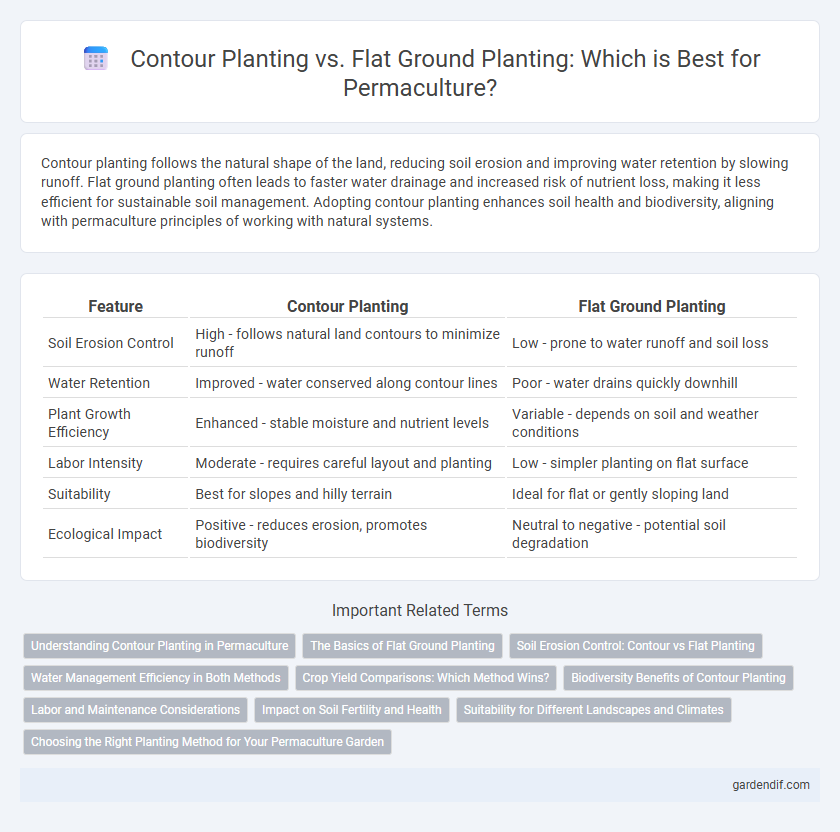
Contour planting vs flat ground planting Illustration
Contour planting follows the natural shape of the land, reducing soil erosion and improving water retention by slowing runoff. Flat ground planting often leads to faster water drainage and increased risk of nutrient loss, making it less efficient for sustainable soil management. Adopting contour planting enhances soil health and biodiversity, aligning with permaculture principles of working with natural systems.
Table of Comparison
| Feature | Contour Planting | Flat Ground Planting |
|---|---|---|
| Soil Erosion Control | High - follows natural land contours to minimize runoff | Low - prone to water runoff and soil loss |
| Water Retention | Improved - water conserved along contour lines | Poor - water drains quickly downhill |
| Plant Growth Efficiency | Enhanced - stable moisture and nutrient levels | Variable - depends on soil and weather conditions |
| Labor Intensity | Moderate - requires careful layout and planting | Low - simpler planting on flat surface |
| Suitability | Best for slopes and hilly terrain | Ideal for flat or gently sloping land |
| Ecological Impact | Positive - reduces erosion, promotes biodiversity | Neutral to negative - potential soil degradation |
Understanding Contour Planting in Permaculture
Contour planting in permaculture maximizes water retention and minimizes soil erosion by aligning crops along natural land contours, which contrasts with flat ground planting that often leads to runoff and nutrient loss. This technique enhances soil fertility and moisture levels, promoting healthier plant growth and sustainable land use. Implementing contour planting supports ecosystem stability by preserving topsoil and improving water infiltration in permaculture systems.
The Basics of Flat Ground Planting
Flat ground planting involves sowing seeds or transplanting crops on level surfaces without altering the natural slope of the land, promoting simplicity and ease of maintenance. This method allows for straightforward irrigation and mechanization, making it suitable for large-scale conventional farming but may increase risks of soil erosion and water runoff compared to contour planting. Soil preparation and management practices like mulching and cover cropping are essential in flat ground planting to preserve soil structure and fertility.
Soil Erosion Control: Contour vs Flat Planting
Contour planting significantly reduces soil erosion by following the natural topography, creating barriers that slow water runoff and increase water infiltration, which stabilizes the soil. In contrast, flat ground planting allows water to flow rapidly across the surface, leading to higher erosion rates and nutrient loss. Employing contour planting techniques is essential for maintaining soil health, especially on sloped terrains vulnerable to degradation.
Water Management Efficiency in Both Methods
Contour planting significantly enhances water management efficiency by reducing runoff and promoting water infiltration along the natural land slope. Flat ground planting often leads to higher water runoff and soil erosion due to the lack of natural water flow control, making it less effective in water retention. Implementing contour planting in permaculture designs maximizes soil moisture conservation and supports sustainable agricultural productivity.
Crop Yield Comparisons: Which Method Wins?
Contour planting significantly enhances crop yield by reducing soil erosion and improving water retention compared to flat ground planting. Studies show contour planting can increase yields by up to 20% due to better nutrient absorption and moisture availability. Flat ground planting often leads to nutrient runoff and lower soil fertility, resulting in comparatively reduced agricultural productivity.
Biodiversity Benefits of Contour Planting
Contour planting enhances biodiversity by creating microhabitats along the slope, which support diverse plant and animal species compared to flat ground planting. The variation in moisture retention and soil composition on contour rows promotes a wider range of native vegetation and beneficial insects. This diversity improves ecosystem resilience, pest control, and pollination within permaculture systems.
Labor and Maintenance Considerations
Contour planting reduces soil erosion and water runoff, decreasing the need for frequent soil amendments and labor-intensive repairs. Flat ground planting often requires more intensive irrigation management and frequent weeding, increasing ongoing maintenance demands. Choosing contour planting in permaculture systems optimizes labor efficiency and sustains soil health with less manual intervention.
Impact on Soil Fertility and Health
Contour planting enhances soil fertility by reducing erosion and promoting water retention, which encourages microbial activity and organic matter accumulation. Flat ground planting often results in increased runoff and nutrient loss, leading to soil compaction and diminished microbial health. Maintaining contour lines supports a balanced soil ecosystem, fostering sustainable nutrient cycling and improved crop resilience.
Suitability for Different Landscapes and Climates
Contour planting enhances water retention and soil conservation on sloped terrains by following natural land elevations, making it ideal for hilly or mountainous regions with variable rainfall patterns. Flat ground planting is more suitable for level landscapes where water distribution is uniform and soil erosion risk is minimal, fitting well in areas with stable climate conditions. Selecting the appropriate method depends on the topography and local climate to optimize plant growth and sustainable land use.
Choosing the Right Planting Method for Your Permaculture Garden
Contour planting enhances water retention and soil erosion control by following the natural landscape, making it ideal for sloped permaculture gardens. Flat ground planting suits level areas, offering easier access and uniform water distribution but may require additional erosion management. Selecting between these methods depends on your garden's topography, water flow patterns, and long-term soil health goals to maximize sustainability and productivity.
Contour planting vs flat ground planting Infographic

 gardendif.com
gardendif.com